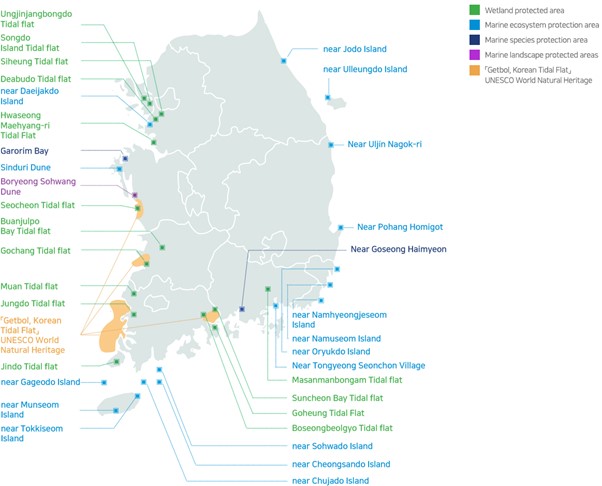On The Value of New Coastal Protected Areas in South Korea
6/6/20233 min read


Summary: Given South Korea’s peninsular structure and its resulting susceptibility to floods and higher sea levels, it may be worth considering gazetting new coastal protected areas (“PAs”), particularly along the east coast. This measure could have the effect of facilitating adaptation to the impacts of climate change while concurrently protecting the diverse coastal and wetland species dependent on those habitats.
South Korea is circumscribed by sea on three sides and includes more than 3,400 islands, and therefore possesses a substantial coastline (Kwon et al 2016). Both temperatures and rainfall have risen in recent times, and the country is projected to experience increased precipitation (The National Atlas of Korea (a)). It is therefore vulnerable to flooding and rising sea levels, particularly in eastern low-lying coastal regions, which are vulnerable to heat from the Kuroshio warm current from the eastern Philippines and generally from the East Sea (The National Atlas of Korea (c)).
Currently, 34 marine areas – predominantly coastal – have been designated as PAs (KOEM), as follows:-


(Source: KOEM)
“About 46.8 percent of the country’s total fish production comes from shallow coastal farming, followed by 34.3 percent from deep-sea fishing, 18.1 percent from coastal sea fishing, and 0.9 percent from inland fishing.”
(Kwon et al 2016:142)
Coastal areas perform significant roles in Korean livelihoods and wellbeing.
A high proportion of South Korea’s fishing villages are located along low and rocky coasts (Kwon et al 2016). The beaches of the eastern coast are socio-economically integral to tourism by virtue of its comparatively smooth coastline, the depth of waters, and its dynamic surf (Kwon et al 2016). The relatively even topography, moderate climes, and plenitude of arable lands have also resulted in dense populations along the southern and western coasts (Kwon et al 2016).
With rigorous supervision and approval for sustainable resource exploitation, the new PAs may potentially meet both long- and short-term conservation and development objectives.
In the example of the Rapa Nui marine protected area of Chile, Indigenous residents were involved in the design of the PA and are permitted to continue their traditional modes of fishing, resulting in 140 species of native fish being saved from overfishing (The Economist 2020).
The administration of the proposed new PAs should serve not only conservation goals but also the development, welfare, and livelihoods of affected local populations, permitting sustainable use of the natural resources within the protected zones (Oldekop and Holmes 2015). Political will, robust enforcement and dispute resolution procedures, as well as co-leadership and co-management by local residents, have been observed to be drivers of successful PA conservation efforts (Maxwell et al 2020). To further ensure positive and synergistic conservation and socio-economic outcomes, not only must local communities be represented in and encouraged to participate in the decision-making process concerning the delineation and management of the PAs, there will also be a need to strengthen existing institutional capacity and accountability at the national level (Oldekop and Holmes 2015).
(485 words)
References:
KOEM. ‘Designation and Management of Marine Protected Areas’. https://www.koem.or.kr/site/eng/02/10201040000002019071509.jsp
Kwon, S., J. Kim, E-H Lee, and C-Y Jung. (2016). ‘Geography of Korea’. Translated by D. Kane. Understanding Korea No. 7. The Academy of Korean Studies. Seoul Selection 2016. ISBN: 978-89-97639-67-0 03980 https://www.aks.ac.kr/ikorea/upload/intl/korean/UserFiles/UKS7_Geography_of_Korea_eng.pdf
Maxwell, S.L., V. Cazalis, N. Dudley, M. Hoffman, A.S.L. Rodrigues, S. Stolton, P. Visconti, S. Woodley, N. Kingston, E. Lewis, M. Maron, B.B.N. Strassburg, A. Wenger, H.D. Jonas, O. Venter and J.E.M. Watson. (2020). ‘Area-based conservation in the twenty-first century’. Nature 586 (7828) 2020, pp.217–227.
Oldekop, J.A. and G. Holmes (2015). ‘A global assessment of the social and conservation outcomes of protected areas’. The Society for Conservation Biology.
The Economist. (2020). ‘Chile’s Marine Protected Areas: a case study in coastal governance?’ 24 June 2020. https://impact.economist.com/ocean/biodiversity-ecosystems-and-resources/chiles-marine-protected-areas-a-case-study-in-coastal-governance
The National Atlas of Korea (a). ‘Climate Change’. http://nationalatlas.ngii.go.kr/pages/page_1275.php
The National Atlas of Korea (b). ‘National Parks and Protected Areas’. http://nationalatlas.ngii.go.kr/pages/page_1306.php
The National Atlas of Korea (c). ‘Sea Level Rise’. http://nationalatlas.ngii.go.kr/pages/page_775.php